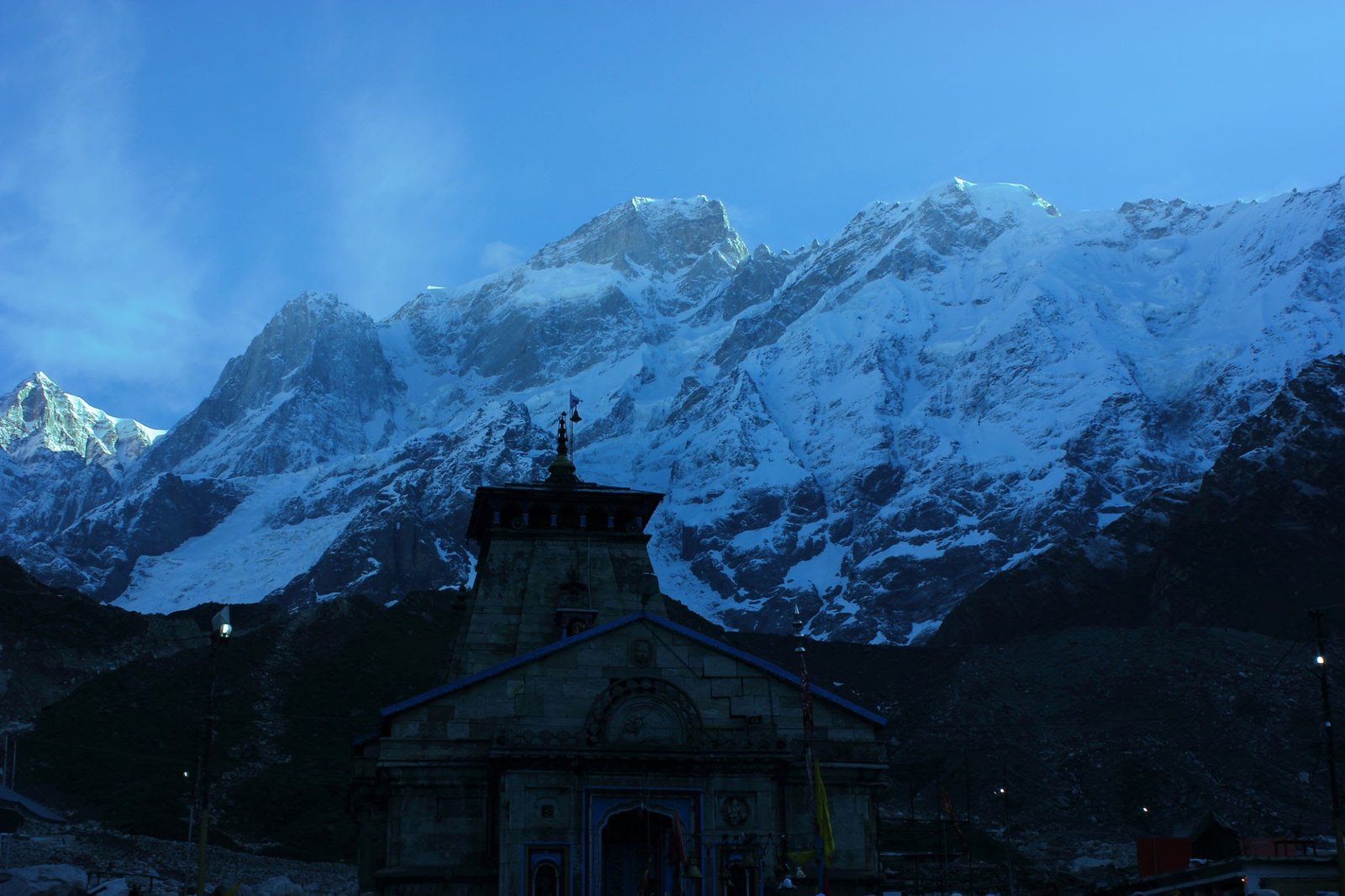Kedarnath Temple is one of the most important pilgrimage sites for Hindus and a sacred abode of Lord Shiva. Located in the Himalayas of Uttarakhand, this temple stands as a symbol of faith, devotion, and resilience. It is one of the twelve Jyotirlingas of Lord Shiva and holds immense spiritual and historical importance. The natural beauty of the snow-covered peaks around the temple makes it one of the most peaceful and divine places in India.
Where Is Kedarnath Temple Located?
The Kedarnath Temple in India is situated in the Rudraprayag district of Uttarakhand. It lies near the Mandakini River at an elevation of about 3,583 meters (11,755 feet) above sea level. The Kedarnath Temple elevation makes it one of the highest and most scenic temples in the country. Surrounded by snow-capped peaks and lush valleys, it offers an unforgettable spiritual experience.
Pilgrims visiting this temple usually travel through Gaurikund, which is the last motorable point before the trek begins. From there, it’s a 16-kilometer journey on foot or by pony or helicopter services. The location adds a sense of adventure and devotion to the pilgrimage.
The Historical Significance of Kedarnath Temple
The history of Kedarnath Temple dates back thousands of years. According to ancient records, it was originally built by the Pandavas after the Mahabharata war as a tribute to Lord Shiva. Later, Adi Shankaracharya restored and renovated the temple in the 8th century.
The Kedarnath Temple history reflects the deep spiritual connection between humans and divine power. Its stone construction has survived several natural calamities, including earthquakes and floods. The solid grey stones and intricate carvings show the architectural brilliance of ancient India.
The Story of Kedarnath Temple
The story of Kedarnath Temple is rooted in Hindu mythology. After the Kurukshetra war, the Pandavas sought Lord Shiva’s forgiveness for killing their relatives. To avoid them, Lord Shiva disguised himself as a bull and disappeared into the ground. When Bhima tried to hold him, the hump of the bull remained at Kedarnath.
This place became the site of the Shri Kedarnath Jyotirlinga Temple. It is believed that Lord Shiva’s divine energy still resides here, and his blessings cleanse one’s sins and grant peace. The spiritual vibration around the temple fills every visitor with faith and humility.
Shri Kedarnath Jyotirlinga Temple and Its Religious Importance
Among the twelve Jyotirlingas of Lord Shiva, the Shri Kedarnath Jyotirlinga Temple holds a special place. It is also one of the four major sites of the Chota Char Dham Yatra, along with Badrinath, Gangotri, and Yamunotri.
Every year, thousands of devotees visit the temple between April and November when it remains open. During winter, the deity is shifted to Ukhimath, where worship continues until the temple reopens in summer. Daily rituals and evening aartis create a deeply spiritual atmosphere, drawing devotees from all over the world.
Architecture and Structure of Kedarnath Temple
The Kedarnath Temple entrance faces south, unlike most Hindu temples which face east. The temple is made of massive stone slabs arranged tightly together without any mortar. Despite its height and weather conditions, the structure has survived earthquakes and heavy snowfalls.
The inner sanctum, or Garbhagriha, houses the natural rock-shaped lingam that represents Lord Shiva. The temple’s design, with its tall conical roof and stone walls, reflects the remarkable skills of ancient architects who built it to endure extreme Himalayan conditions.
The Natural Beauty Around the Himalaya Kedarnath Temple
The Himalaya Kedarnath Temple is surrounded by majestic mountains and glaciers. The Mandakini River flows nearby, adding to the peaceful charm of the place. Pilgrims trekking towards the temple are greeted with breathtaking views of snow-covered peaks, waterfalls, and green valleys.
The silence of the Himalayas and the rhythmic sound of temple bells create an atmosphere of deep devotion. Nature and spirituality blend perfectly here, making it one of the most divine destinations in India.
Best Time to Visit Kedarnath Temple
The Kedarnath Temple in Uttarakhand opens every year in late April or early May and closes by November before heavy snowfall begins. The best time to visit is between May and June or from September to October. During these months, the weather is pleasant, and the trekking path remains open.
Pilgrims should avoid the monsoon months as the region receives heavy rainfall, which can make travel risky. Visiting during the early season ensures you experience both spiritual peace and scenic beauty.
Travel Guide — How to Reach Kedarnath Temple
To reach Kedarnath Temple, pilgrims usually start their journey from Rishikesh, Haridwar, or Dehradun. From these points, buses and taxis are available to Gaurikund. From Gaurikund, one can trek to the temple or use helicopter services from Phata, Sersi, or Guptkashi.
Helicopter rides are popular for elderly devotees and those who wish to avoid the long trek. Along the route, accommodation and food facilities are available. Local guest houses and dharamshalas provide simple yet comfortable stays.
Kedarnath Temple After the 2013 Flood
In 2013, a massive flood struck Kedarnath Valley, causing severe destruction. However, the Kedarnath Temple miraculously remained safe. Devotees believe it was divine protection from Lord Shiva. Since then, the government and local authorities have rebuilt roads, shelters, and safety systems to protect pilgrims and ensure a safer yatra.
Today, the temple stands stronger than ever, symbolizing endurance and faith amidst adversity.
Interesting Facts About Kedarnath Temple
- The temple stands without any binding material between stones.
- Despite being hit by natural disasters, it remains unharmed.
- The lingam inside the temple is pyramid-shaped, unlike other Shiva temples.
- It is believed that Adi Shankaracharya attained salvation near Kedarnath.
These facts make Kedarnath Temple in India not just a place of worship but a living miracle of faith and architecture.
FAQs About Kedarnath Temple
1. What is the elevation of Kedarnath Temple?
The temple stands at an elevation of about 3,583 meters above sea level.
2. Who built the Kedarnath Temple?
It is believed to have been built by the Pandavas and later revived by Adi Shankaracharya.
3. Why is Kedarnath Temple famous?
It is one of the twelve Jyotirlingas and an important site of the Chota Char Dham Yatra.
4. How can one reach Shri Kedarnath Jyotirlinga Temple?
Pilgrims can reach via trekking from Gaurikund or by helicopter from nearby helipads.
5. When does Kedarnath Temple open every year?
The temple opens in April or May and closes by November due to snowfall.
Conclusion
The Kedarnath Temple is not just an ancient monument but a timeless symbol of faith and devotion. Located in the Himalayas of Uttarakhand, it stands as a reminder of divine energy, human belief, and natural beauty. Every pilgrim who visits the Shri Kedarnath Jyotirlinga Temple feels a deep connection with Lord Shiva and leaves with a heart full of peace and blessings.
Krishna Mishra writes for Insights of Hinduism, where he shares heartfelt thoughts on festivals, traditions, and the timeless wisdom of Sanatan Dharma. His aim is to keep the essence of Hindu culture alive in a way that feels simple, authentic, and relatable to everyone.


